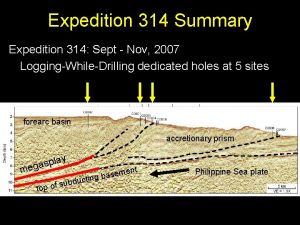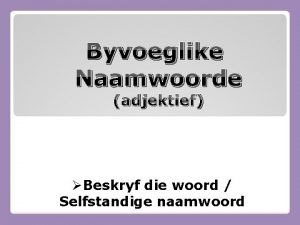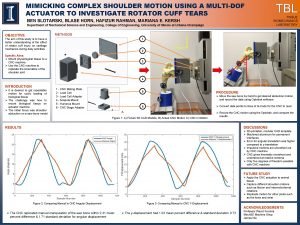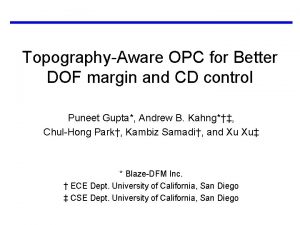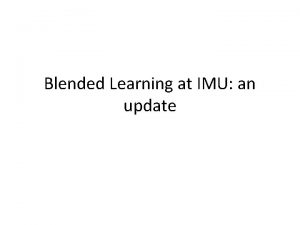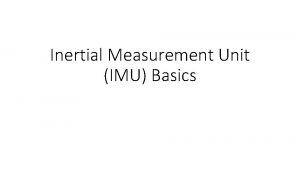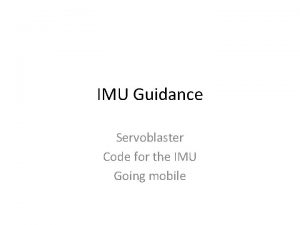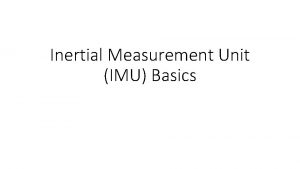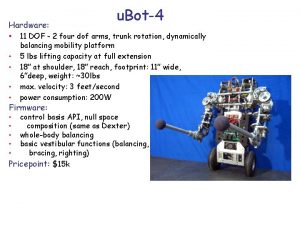Applying a 3 DOF Orientation Tracker IMU as














- Slides: 14

Applying a 3 DOF Orientation Tracker (IMU) as a Human-Robot Interface for Autonomous Wheelchairs Christian Mandel, Thomas Röfer, Udo Frese

Applying a 3 DOF Orientation Tracker (IMU) as a Human-Robot Interface for Autonomous Wheelchairs Motivation • control of smart wheelchairs for people suffering from quadriplegia asks for suitable interface methods • available approaches employ still functioning communication channels like - direction of gaze § computer vision [Canzler et al. 2004] § electro-oculographic potential (EOG) [Gips 1998, Yanco 1998] - voice § coarse qualitative route descriptions [Mandel et al. 2006] - head posture § ultrasonic sensors [Jaffe 1982, Ford 1995] § inertial measurement units (IMU) [Chen 2003] - brain computer interfaces (BCI) § dependent / independent BCIs [Vanacker ? ? ? , Millan 2006] 2

Applying a 3 DOF Orientation Tracker (IMU) as a Human-Robot Interface for Autonomous Wheelchairs Preliminary Work: Human Robot Interfaces • interpretation of coarse qualitative route descriptions via the mapping of pairs of spatial relations and landmarks onto annotated route graphs along the blue path front-left of me 3

Applying a 3 DOF Orientation Tracker (IMU) as a Human-Robot Interface for Autonomous Wheelchairs Prerequisite: Low Level Safety Layer • for each combination of (discretized) rotational velocity (w) and translational velocity (v) precompute virtual sensor vs(v, w) • at runtime vs(v, w) allows for fast collision detection within local obstacle map • safety layer intervenes by setting v and w to zero if obstacle is located within dangerous part of virtual sensor 4

Applying a 3 DOF Orientation Tracker (IMU) as a Human-Robot Interface for Autonomous Wheelchairs IMU based Head-Joystick: Basic Idea • three degrees of freedom orientation tracker, mounted at the back of the user`s head serves as suitable controlling equipment for an automated wheelchair • pitch-axis controls translational speed (v) roll-axis controls rotational speed (w) free yaw-axis allows user to look around • proportional control: doubling the head`s pitch or roll angle doubles v or w respectively • safety layer monitors sorrounding obstacles and prevents from collisions 5

Applying a 3 DOF Orientation Tracker (IMU) as a Human-Robot Interface for Autonomous Wheelchairs IMU based Head-Joystick: Calibration • calibration determines minimal and maximal pitch and roll deflection of a particular user`s head • dead zone around head`s point of rest defines interval of disregarded head movements 6

Applying a 3 DOF Orientation Tracker (IMU) as a Human-Robot Interface for Autonomous Wheelchairs IMU based Head-Joystick: Static vs. Dynamic Roll Dead Zone • linear, quadratic, or cubic mapping of head posture onto translational and rotational velocity • static roll dead zone constrains rotational velocity to zero if the head`s roll angle is within a static intervall around the head`s rest position • dynamic roll dead zone increases increasing head`s pitch angle with 7

Applying a 3 DOF Orientation Tracker (IMU) as a Human-Robot Interface for Autonomous Wheelchairs IMU based Head-Joystick: Experimental Evaluation standard joystick 111 ms Safety Layer Interventions head-joystick (static roll dead zone) 445 ms 8 head-joystick (dynamic roll dead zone) 94 ms

Applying a 3 DOF Orientation Tracker (IMU) as a Human-Robot Interface for Autonomous Wheelchairs IMU based Head-Joystick: Experimental Evaluation 9

Applying a 3 DOF Orientation Tracker (IMU) as a Human-Robot Interface for Autonomous Wheelchairs IMU based Path Planner Interface: Basic Idea • assumption 1: fixed height of user`s head • assumption 2: level surface • line of sight intersects with surface and determines target position • orientation in target position is given by obstacle situation • local path planner computes obstacle free paths to target pose by means of cubic Bezier curves 10

Applying a 3 DOF Orientation Tracker (IMU) as a Human-Robot Interface for Autonomous Wheelchairs IMU based Path Planner Interface: Mapping Head Posture to Target Pose • line of sight is given by - assumed eyepoint e - head`s pitch angle - head`s yaw angle • problem of drifting delta between head`s yaw angle and odometry heading • orientation in target position t is given by tangent in t to actual distance grid, pointing away from wheelchair 11

Applying a 3 DOF Orientation Tracker (IMU) as a Human-Robot Interface for Autonomous Wheelchairs IMU based Path Planner Interface: Cubic Bezier Curve Search Space • p 0 and p 1 predetermined by current pose and targeted pose • p 1 and p 2 span search space of possible solution paths • computational payload example: 4400 curves x 100 curve points x 132 contour points = O(58*106) collision tests • need for efficient collision test 12

Applying a 3 DOF Orientation Tracker (IMU) as a Human-Robot Interface for Autonomous Wheelchairs IMU based Path Planner Interface: Proof of Concept • estimated path of an approximately 127 m long test run triggered by head posture dependent target selection and simple voice commands 13

Applying a 3 DOF Orientation Tracker (IMU) as a Human-Robot Interface for Autonomous Wheelchairs References • [Canzler 2004] „Person-adaptive facial feature analysis for an advanced wheelchair user-interface“ in Proceedings of the IEEE Intl. Conf. on Mechatronics and Robotics, 2004 • [Gips 1998] „On building intelligence into eagleeyes“ in Lecture Notes in AI: Assistive Technology and Artificial Intelligence, 1998 • [Yanco 1998] „Wheelesley, a robotic wheelchair system: Indoor navigation and user interface“ in Lecture Notes in AI: Assistive Technology and Artificial Intelligence, 1998 • [Mandel 2006] „Robot navigation based on the mapping of coarse qualitative route descriptions to route graphs“ in Proceedings of the IEEE Intl. Conf. on Intelligent Robots and Systems, 2006 • [Jaffe 1982] „An ultrasonic head position interface for wheelchair control“ in Journal of Medical Systems, 1982 • [Ford 1995] „Ultrasonic head controller for powered wheelchairs“ in Journal of Rehabilitation Research and Development, 1995 • [Chen 2003] „A head oriented wheelchair for people with disabilities“ in Disability and Rehabilitation, 2003 • [Vanacker ? ? ? ] „Context-based filtering for assisted brain-actuated wheelchair driving“, ? ? ? • [Millan 2006] „Non-invasive brain-actuated control of a mobile robot by human eeg“ in IMIA Yearbook of Medical Informatics, 2006 Thank You! 14




